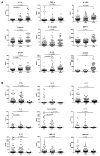Altered serum cytokine signature in common variable immunodeficiency
- PMID: 25246148
- PMCID: PMC4870003
- DOI: 10.1007/s10875-014-0099-z
Altered serum cytokine signature in common variable immunodeficiency
Abstract
Purpose: Common variable immunodeficiency (CVID) is the most frequent form of primary symptomatic hypogammaglobulinemia. CVID patients display a number of abnormalities in lymphocyte subpopulations including chronic T-cell activation and decreased numbers of circulating CD4(+) T cells and NK cells. We and others have recently shown that CVID is associated with increased concentration of soluble CD14 (sCD14) and other factors indicating limited microbial translocation.
Methods: To address the mechanisms of chronic immune activation in CVID, we performed a detailed analysis of cytokine serum levels in 36 patients with CVID, 52 patients with selective IgA deficiency (IgAD), and 56 healthy volunteers.
Results: We show that CVID is associated with elevated serum levels of CXCL-10/IP-10, IL-1R antagonist, TNF-α, IL-10, IL-12 (p40), CCL-2/MCP-1, G-CSF, and CCL-11/eotaxin. The detected cytokine signature is consistent with an ongoing activation of cells of myeloid lineage. In contrast, the levels of cytokines typically produced by CD4(+) T helper cells of Th1 (IFN-γ, IL-2), Th2 (IL-9, IL-13), and Th17 (IL-17) subtypes were suppressed in CVID patients compared to healthy donors.
Conclusions: Presented data suggest that the altered cytokine profile observed in patients with CVID may be attributed to the activation of monocyte-macrophage and granulocyte lineages, possibly driven by the translocation of bacterial components across the gastrointestinal or respiratory tracts mucosal barrier.
Conflict of interest statement
The authors have no conflict of interest to disclose.
Figures


Similar articles
-
Chronic immune activation in common variable immunodeficiency (CVID) is associated with elevated serum levels of soluble CD14 and CD25 but not endotoxaemia.Clin Exp Immunol. 2012 Dec;170(3):321-32. doi: 10.1111/j.1365-2249.2012.04655.x. Clin Exp Immunol. 2012. PMID: 23121673 Free PMC article.
-
CD4+CD25+Foxp3+ T regulatory cells, Th1 (CCR5, IL-2, IFN-γ) and Th2 (CCR4, IL-4, Il-13) type chemokine receptors and intracellular cytokines in children with common variable immunodeficiency.Int J Immunopathol Pharmacol. 2016 Jun;29(2):241-51. doi: 10.1177/0394632015617064. Epub 2015 Dec 18. Int J Immunopathol Pharmacol. 2016. PMID: 26684629 Free PMC article.
-
Impaired CD8(+) T cell responses upon Toll-like receptor activation in common variable immunodeficiency.J Transl Med. 2016 May 17;14(1):138. doi: 10.1186/s12967-016-0900-2. J Transl Med. 2016. PMID: 27188997 Free PMC article.
-
[Cytokines in children with immunodeficiencies].Folia Med Cracov. 1999;40(1-2):5-97. Folia Med Cracov. 1999. PMID: 10909468 Review. Polish.
-
Cytokines in common variable immunodeficiency as signs of immune dysregulation and potential therapeutic targets - a review of the current knowledge.J Clin Immunol. 2014 Jul;34(5):524-43. doi: 10.1007/s10875-014-0053-0. Epub 2014 May 15. J Clin Immunol. 2014. PMID: 24827633 Review.
Cited by
-
Common Variable Immunodeficiency patients with a phenotypic profile of immunosenescence present with thrombocytopenia.Sci Rep. 2017 Jan 5;7:39710. doi: 10.1038/srep39710. Sci Rep. 2017. PMID: 28054583 Free PMC article.
-
Adiponectin Receptors and Pro-inflammatory Cytokines Are Modulated in Common Variable Immunodeficiency Patients: Correlation With Ig Replacement Therapy.Front Immunol. 2019 Nov 27;10:2812. doi: 10.3389/fimmu.2019.02812. eCollection 2019. Front Immunol. 2019. PMID: 31827477 Free PMC article.
-
Total and High Molecular Weight Adiponectin Expression Is Decreased in Patients with Common Variable Immunodeficiency: Correlation with Ig Replacement Therapy.Front Immunol. 2017 Jul 31;8:895. doi: 10.3389/fimmu.2017.00895. eCollection 2017. Front Immunol. 2017. PMID: 28824624 Free PMC article.
-
Targeted Proteomics Reveals Inflammatory Pathways that Classify Immune Dysregulation in Common Variable Immunodeficiency.J Clin Immunol. 2021 Feb;41(2):362-373. doi: 10.1007/s10875-020-00908-1. Epub 2020 Nov 15. J Clin Immunol. 2021. PMID: 33190167 Free PMC article.
-
The biological basis for current treatment strategies for granulomatous disease in common variable immunodeficiency.Curr Opin Allergy Clin Immunol. 2024 Dec 1;24(6):479-487. doi: 10.1097/ACI.0000000000001032. Epub 2024 Oct 21. Curr Opin Allergy Clin Immunol. 2024. PMID: 39431514 Free PMC article. Review.
References
Publication types
MeSH terms
Substances
Grants and funding
LinkOut - more resources
Full Text Sources
Other Literature Sources
Research Materials
Miscellaneous

